
DB1-first of the DB Astons It’s 70 years since Aston launched the 2-litre Sports (aka DB1). We drive one. Launched 70 years ago, the 2-litre Sports (aka DB1) was the first production model of the David Brown era and remains one of the rarest of all Aston s. But what’s it like to drive? Time to find out. Words John Simister. Photography by Tim Andrew.
CLASSIC DRIVE DB FIRST OF THE LINE
We’re munching fish and chips by the beach on Hayling Island, snapper Tim Andrew and I. Parked yards away is a metallic green sports tourer of early post-war style, curvaceous and imposing. People are intrigued by it as they head to the sand and the sea. ‘What is it?’ we hear them ask each other. Then they see the nose, parked facing the fence. ‘Wow! It’s an Aston Martin!’
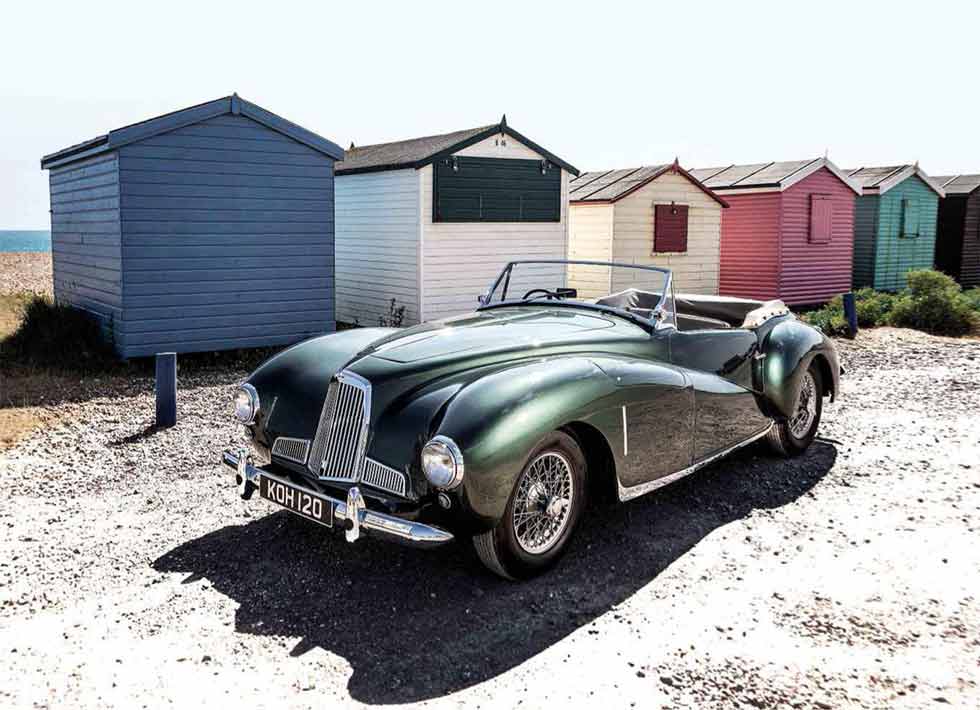
Indeed it is, but not an Aston anyone recognises. This does not conform to their mental template, doubtless Bond-influenced, of an old Aston Martin. They don’t quite believe it until the reality of the identity has had a chance to settle.
It’s not surprising that they haven’t seen one before, because only 14 were built. Nor had I until today, other than in photographs. But here it is, large as life: the Aston Martin DB1.
Plenty of people saw car number AMC/49/6 at the 1949 London Motor Show at Earls Court, though, because it was Aston Martin’s show car bearing the exhibition plate AM 1950. That was the second time an Aston Martin 2-litre Sports, the company’s first post-war car, had been on show there, the model’s debut happening a year earlier – 70 years ago this year – when it competed for attention with new-wave cars such as the Jaguar XK100 and XK120. XK100? We’ll return to that later.

With seafood consumed, it’s time to swing open the wide, heavy doors of our DB1, or 2-litre Sports, and swing out of the car park to the exhaust’s flat, puttery blare – like that of a small, petrol-fuelled aero engine of considerable vintage – and sweep away on its easy ladlings of torque. And wonder about this car’s conception and birth during one of the more significant of Aston Martin’s various reincarnations.
The DB1 name was applied retrospectively and was never used by Aston Martin itself at the time, just as any model line that proves over time to spawn several ‘marks’ isn’t described as ‘Mkl’ on its launch. It was David Brown who got the 2-litre Sports project under way, though, almost as soon as he bought the Aston Martin company (and Lagonda) in 1947.
‘The exhaust’s flat, puttery blare is like that of a small, petrol-fuelled aero engine’
With Aston Martin came chief engineer Claude Hill, whose automotive career began in 1924 as a protege of ‘Bert’ Bertelli, Aston’s engineering driving force through much of the 1920s and 1930s. Keen to forge a forward- looking plan for Aston Martin even as war loomed, Hill had created the curious Atom saloon in 1939. He was no stylist, as the Atom amply demonstrated, but he had plenty of original engineering ideas as well as, reportedly, the ability to quote the decimal equivalents, to six decimal places, of all sixty-fourths fractions from one to 64 straight from the top of his head. Most of us think in words, but Claude Hill thought equally fluently in numbers.
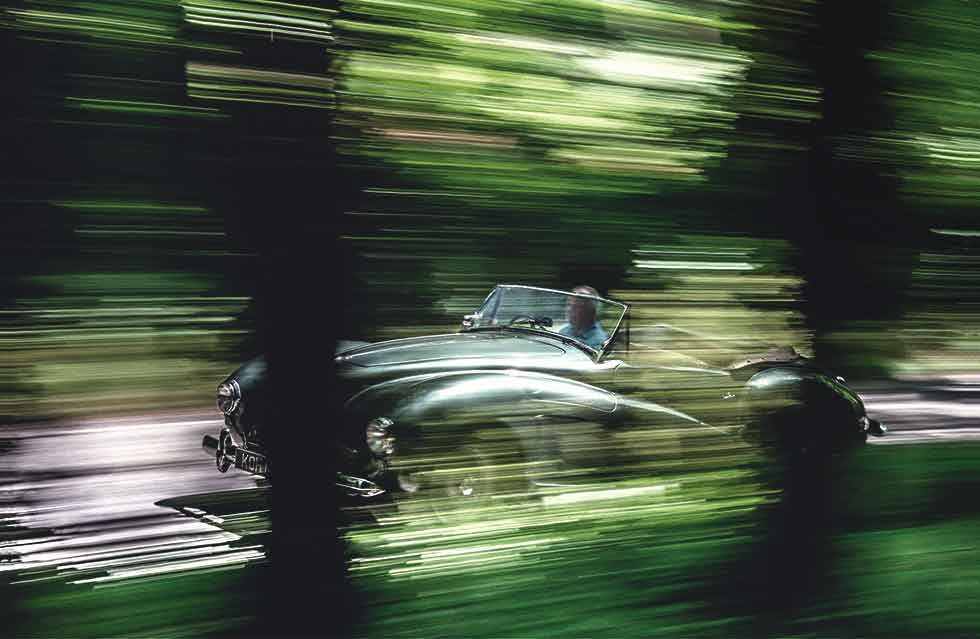
He was particularly keen on engines. During the war years he devised a new 2-litre engine for the Atom, finally breaking away from the Bertelli-era overhead-camshaft motors with his new pushrod design, still with four cylinders but shorter in the stroke and with five main bearings for the crankshaft.
David Brown liked the Atom’s engineering, but it wasn’t the glamorous sportster he thought Aston Martin should be building. So the 2-litre Sports, with Hill’s new engine, took shape using a version of the Atom’s chassis strengthened to compensate for the lack of a roof. This proved necessary, observed ex-Lagonda stylist Frank Feeley now re-acquired by Brown for both marques, because ‘the moment you stood in it, the thing bent. I never saw such a weak car.’
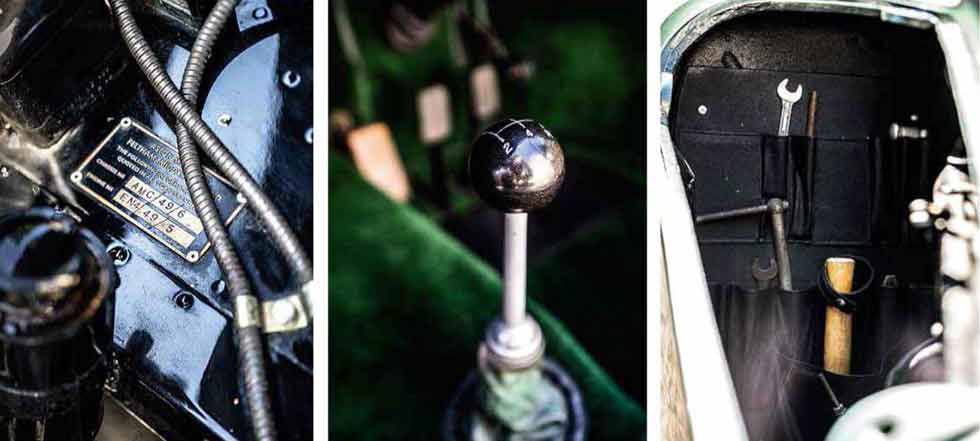
Feeley’s first Aston Martin body design, as you can see, is quite a flamboyant collection of curves. Here, too, is where the archetypal Aston Martin front grille shape began: high in the middle, the central part’s shape derived from the marque’s pre-war radiators, but flanked by low side grilles with chamfered ends. The first DB2s had a squatter version of this grille-work before the three elements fused, and then later became (in the DB Mklll) the flatter, wider, gentler shape topologically varied right up to now in one form or another.
With the 2-litre Sports, we’re at the stage in the evolution of car styling where the form is still inspired by separate wings and a bonnet tapering towards the front grille – as with most pre-war cars – but the gaps have been filled in, the sweeping front wings flow into the doors and the headlights no longer stand on stalks. Usually, in this genre, they flank the grille inboard of the wings, but the more modern way was to pull the headlights out to the wings themselves, as here.
As seen at the Earls Court show, and in contemporary publicity shots with youthful comedian Frankie Howerd, AMC/49/6 was originally painted dark green. It also had a flat, fold-down windscreen and removable side-screens, in basic sports-car fashion. That was unusual for a 2-litre Sports; most had a two- piece vee’d windscreen, quarter-lights in the doors and wind-up windows.
Mr AGF Oldworth, who acquired the Aston in 1953, thought this spartan-ness unnecessary, so in 1954 he commissioned some changes from – it has been thought in the past but is now uncertain – Abbott of Farnham. Best known for factory-sanctioned conversion of Ford Consuls, Zephyrs and Zodiacs into estate cars, Abbott also coach-built bodies for grand luxury cars.
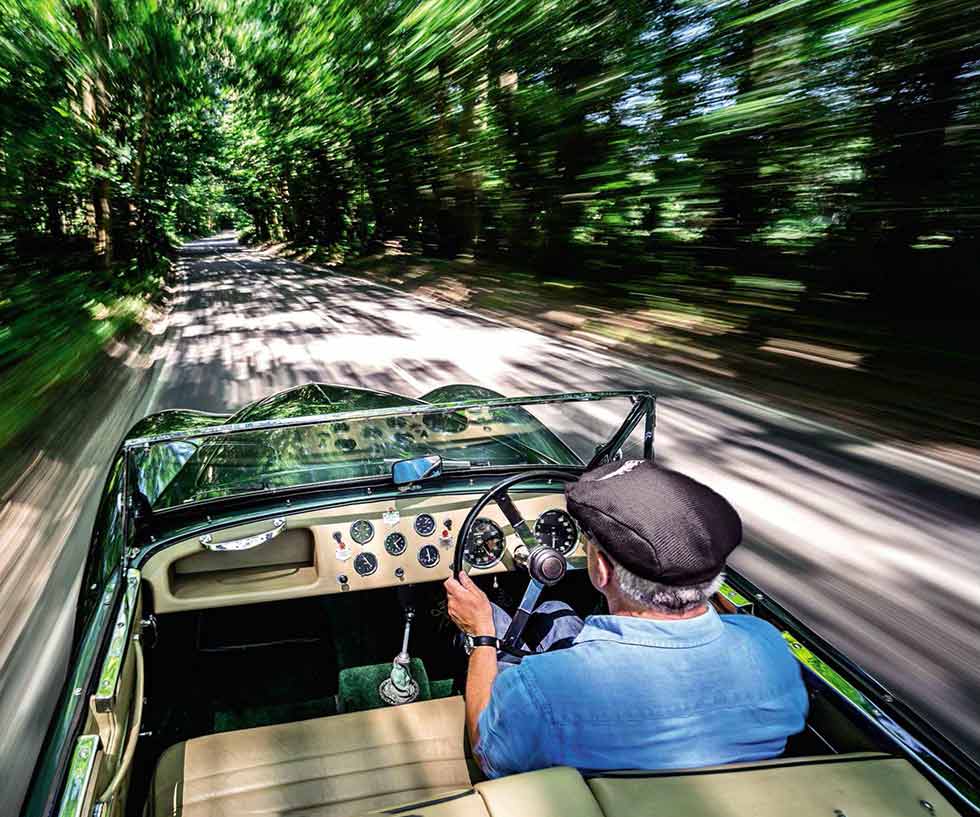
Abbott, if Abbott it was, devised quarter- lights fixed to the scuttle – there was room because the edges of the flat windscreen sat further forward than those of the swept-back vee-screen – and screwed the windscreen frame to them. You could undo some fixings and still fold the ‘screen forward, but why would you? Windscreen wipers were also added, along with wind-up (or down) windows. Cut-outs in the tops of the doors’ inner surfaces still show where the sidescreens were once affixed.
The DB1’s other visual change from its motor show look came much later, during a mid-life restoration. Its rear wings originally had feature lines shooting rearwards from the tops of the arches, as with the front wings, and the rear wheels were almost completely enclosed by spats, except for small cut-outs to give clearance for the knock-on wire wheels’ spinners. The replacement rear wings, however, were and are both spat-less and bereft of feature lines.

And what are those panels set into the tops of the front wings, just ahead of the doors? They are removable, concealing the battery and the jack on the left, the spare wheel on the right. The entire front end ahead of the scuttle is removable, too, should the bonnet opening not give enough access to what lies beneath.
Which is a very rare engine indeed. The idea had been to use it also in the DB2, which was built on a shorter version of the DB1 chassis, but that happened in no more than a couple of prototypes because David Brown also had the Lagonda twin-cam straight-six, which held rather greater sporting appeal than a pushrod four. So it was that Claude Hill’s motor got sidelined, along with the pushrod six that would be derived from it, and with that Hill left Aston Martin Lagonda and decamped to Harry Ferguson and his four-wheel-drive research projects. There he shone: the Ferguson flat-four engine was Hill’s, as was the four-wheel-drive system used in the Jensen FF, the Ferguson P99 GP car and 7-litre Felday 5 sports-racer.
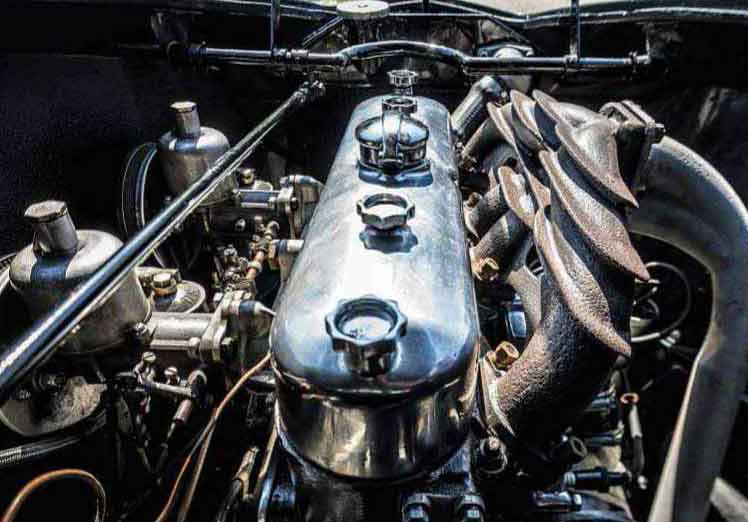
Though rare and short-lived in its production life, Hill’s DB1 motor had a major moment of motorsport glory when prototype LMA /48/1, re-bodied in minimalist fashion with cycle wings, won the 1948 Spa 24 Hours driven by St John ‘Jock’ Horsfall (Aston’s test driver and wartime man of mystery) and Leslie Johnson (the ‘Spa car’ was featured in Vantage issue 21). Another DB1 even appeared at Le Mans, in 1949, completing the race in 11th place at a notably sedate pace. So there is sporting blood in the DB1 underneath the stateliness.
On March 10, 1950, a while after the 1949 Earls Court show, AMC/49/6 was road-registered as KOH 120, a Birmingham number rather than one relating to Feltham, Middlesex because it had been bought by John Cadbury of Bourneville. Yes, that Cadbury family. The original cardboard logbook bears the issuing stamp for a petrol ration book, too. There’s a whole lot of history with this car: bills for work at Feltham, surprising component replacements at low mileages, and the thorough restoration that KOH 120 received in 1992 at Works Service in Newport Pagnell after current owner Simon Draper bought it at auction in 1989.
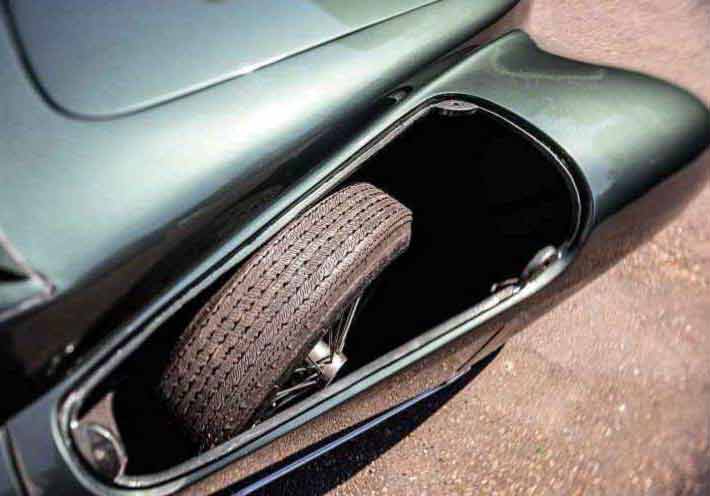
At that point it was dark green. Now it’s in a more typically Aston metallic green and it looks gorgeous. Before we set off on our drive to the coast, though, I want a closer look at Claude Hill’s way of doing things. The engine is unlike any other, its crossflow cylinder head expending its exhaust gases through upwardly angled ports, above the spark plugs, into a high- mounted and extravagantly finned manifold whose two exits would promise free-flowing power were it not for the fact that they join into one almost immediately post-manifold.
The head itself is to ‘Spa’ specification, which means a 9:1 compression ratio instead of the standard 7.25:1 and a gentle power increase to 95bhp from 90. A peek underneath reveals a finned aluminium sump above coil-sprung front suspension, itself based around leading links pivoting on hefty bearings in an oil bath within the front crossmember. Lever-arm dampers form the upper links, and a long fore- and-aft drag link turns a centrally mounted steering pivot to which equal-length trackrods are attached. Unusual, but logical.
At the back we find a coil-sprung live axle located by four parallel radius arms and a Panhard rod, with damping by Koni telescopies. These are new, but Konis have long been KOH 120’s rear dampers of choice.
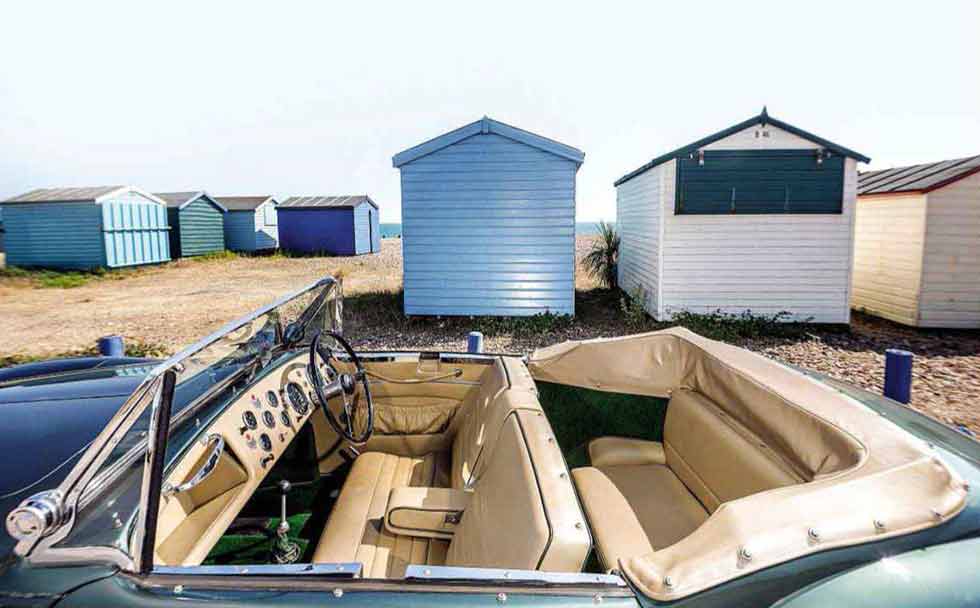
And so to the road, imposing and springy three-spoke steering wheel in your hands, floor- hinged clutch and brake pedals plus a roller- pad throttle under your feet, fold-down centre armrest offering a gesture of lateral location on the leather-covered bench, short and substantial gearlever ultra-precisely actuating four forward ratios within the David Brown gearbox. There’s no synchromesh on first gear, and the accelerator position makes it impossible to heel-and-toe, so you have to think every driving motion through in strict, separate sequence.
Getting into that mindset, refusing to be rushed, soon makes for a drive both calming and invigorating. There’s the play in the steering box common in cars of this era, so you aim for an approximate heading and let the Aston wander gently either side of it unless more assertive action is needed, such as avoiding an oncoming SUV that’s taking up more road than it should.
‘You aim for an approximate heading and let the Aston wander gently either side of it’
A flexible springiness is the best way to describe the DB1’s motion, from the steering, through the structure’s gentle twists and shudders over bumps, to the initially worrying, ultimately faithful response to retardation requests pressed onto the all-drum brakes. This is not a car to hurry through corners, steering weight building as rapidly as the slip-angles under the front pair of Dunlop Road Speed RS5 crossplies, but you soon learn how to make the most of its dynamic traits. And while it’s no powerhouse, that rare engine is full of enthusiasm with lots of response at the start of the throttle travel.
It’s all over by 4800rpm or so on the anti-clockwise tachometer scale, but that suits the DB1’s unflustered demeanour just fine. And the fact that, even on a very hot day, there was not the slightest sign of overheating and the cruising oil pressure stayed resolutely at 70psi according to the gauges on the stark dashboard, shows this to be a car absolutely at ease with itself.
So why did Aston Martin make only 14 of them in three years? The answer might lie in the rakish, temptingly affordable Jaguar, with whose four-cylinder XK100 version the DB1 would have competed directly. But no-one ordered the XK100, favouring instead the six- cylinder XK120, so it never went into production. Given the choice of stately four-cylinder push- rod DB1 or racy six-cylinder twin-cam XK120, which would you have chosen? That’s why the DB2 didn’t arrive a moment too soon.
TECHNICAL DATA FILE SPECIFICATIONS 1949 Aston Martin 2-litre Sports (DB1)
ENGINE In-line 4-cyl, 1970cc, pushrod ohv, 8 valves, twin SU H6 carburettors
MAX POWER 95bhp @ 4750rpm / DIN (nett)
MAX TORQUE 87lb ft @ 2900rpm (est) officially not quoted DIN (nett)
TRANSMISSION Four-speed manual gearbox (synchromesh on upper three ratios), rear-wheel drive
SUSPENSION Front: leading links, coil springs, enclosed anti-roll bar, lever-arm dampers. Rear: live axle, coil springs, upper and lower radius arms, Panhard rod, telescopic dampers
STEERING ‘Adamant’ worm-and-roller steering box
BRAKES Drums
TYRES 6.00 H16 Dunlop Road Speed
WEIGHT 1160kg
POWER TO WEIGHT 83bhp/ton
TOP SPEED 93mph (claimed)
‘While it’s no powerhouse, that rare engine is full of enthusiasm with lots of response at the start of the throttle travel’






